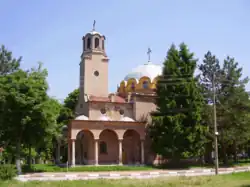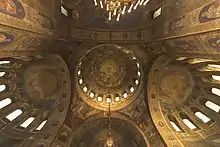Alexander Nevsky Cathedral, Sofia
St. Alexander Nevsky Cathedral (Bulgarian: Храм-паметник "Свети Александър Невски", Hram-pametnik "Sveti Aleksandar Nevski") is a Bulgarian Orthodox cathedral in Sofia, the capital of Bulgaria. Built in Neo-Byzantine style, it serves as the cathedral church of the Patriarch of Bulgaria and it is one of the 50 largest Christian church buildings by volume in the world. It is one of Sofia's symbols and primary tourist attractions.[3] St. Alexander Nevsky Cathedral in Sofia occupies an area of 3,170 square metres (34,100 sq ft) and can hold 5,000 people inside.[3][1] It is among the 10 largest Eastern Orthodox church buildings. It is the largest cathedral in the Balkans. It is believed that up until the year 2000 it was the largest finished Orthodox cathedral.
| The St. Alexander Nevsky Cathedral | |
|---|---|
Храм-паметник "Свети Александър Невски" | |
.jpg.webp) Alexander Nevsky Cathedral, Sofia | |
| Religion | |
| Affiliation | Bulgarian Orthodox |
| Ecclesiastical or organizational status | Stauropegion |
| Leadership | Neophyte of Bulgaria |
| Year consecrated | 1924 |
| Location | |
| Location | Sofia, Bulgaria |
| Geographic coordinates | 42.695833°N 23.332956°E |
| Architecture | |
| Architect(s) | Alexander Pomerantsev |
| Style | Neo-Byzantine |
| Groundbreaking | 3 March 1882 |
| Completed | 1912 |
| Specifications | |
| Capacity | 5000 (worshipers)[1] 86,0003 (volume)[1] |
| Length | 73.5 m[1] |
| Width | 52.2 m[1] |
| Interior area | 3,170 m2[1] |
| Height (max) | 53.0 m (top cross bell tower)[1] |
| Dome height (outer) | 46.3 m (top dome)[1] |
| Dome dia. (outer) | 22 m |
| Dome dia. (inner) | 18 m[2] |
| Website | |
| www | |
History, architecture and construction

The construction of the St. Alexander Nevsky Cathedral started in 1882 (having been planned since 19 February 1879), when the foundation stone was laid, but most of it was built between 1904 and 1912.[3] Saint Alexander Nevsky was a Russian prince. The cathedral was created in honour to the Russian soldiers who died during the Russo-Turkish War of 1877–1878, as a result of which Bulgaria was liberated from Ottoman rule.
The cathedral was designed by Alexander Pomerantsev, aided by Alexander Smirnov and Alexander Yakovlev, as the initial 1884–1885 project of Ivan Bogomolov was radically changed by Pomerantsev. The final design was finished in 1898, and the construction and decoration were done by a team of Bulgarian, Russian, Austro-Hungarian and other European artists, architects and workers, including the aforementioned architects, as well as Petko Momchilov, Yordan Milanov, Haralampi Tachev, Ivan Mrkvička, Vasily Bolotnov, Nikolay Bruni, Alexander Kiselyov, Anton Mitov and many others.

The marble parts and the lighting fixtures were created in Munich, the metal elements for the gates in Berlin, while the gates themselves were manufactured in Karl Bamberg's factory in Vienna, and the mosaics were shipped from Venice.
The Alexander Nevsky Cathedral is a cross-domed basilica featuring an emphasized central dome. The cathedral's gold-plated dome is 45 m high (148 ft) (46.3 m (152 ft) with the cross), with the bell tower reaching 53 metres (174 ft).[3] The roof span of the central nave is 28 metres (92 ft)[4] The temple has 12 bells with total weight of 23 tons, the heaviest weighing 12 tons and the lightest 10 kilograms (22 lb).[3] The interior is decorated with Italian marble in various colours, Brazilian onyx, alabaster, and other luxurious materials. The central dome has the Lord's Prayer inscribed around it, with thin gold letters.[3]
There are many churches in Bulgaria which are smaller copies of St. Alexander Nevsky Cathedral like the temples in the following towns: Valchedram,[5] Sandanski,[6] Dolna Mitropoliya,[7] Kyustendil,[8] Kaspichan,[9] Breznik,[10] Dorkovo village.[11]
 Church of St Paraskeva in Valchedram
Church of St Paraskeva in Valchedram Church of St Demetrius in Dolna Mitropoliya
Church of St Demetrius in Dolna Mitropoliya The Church of Saint Menas in Kyustendil
The Church of Saint Menas in Kyustendil Saint George Church in Breznik
Saint George Church in Breznik
Name changes
The name of the cathedral was briefly changed[3] to the Sts. Cyril and Methodius Cathedral between 1916 and 1920 (since Bulgaria and Russia belonged to opposing alliances in World War I), but then the initial name was restored. The St. Alexander Nevsky Cathedral was consecrated on 12 September 1924 and in 1955 was declared a cultural monument.
Relics
To the left of the altar is a case displaying relics of Alexander Nevsky, given by the Russian Orthodox Church. Although the accompanying Bulgarian-language plaque refers simply to "relics" (мощи), the item on display appears to be a piece of a rib.
Museum and market

There is a museum of Bulgarian icons inside the cathedral crypt, part of the National Art Gallery. The church claims that the museum contains the largest collection of Orthodox icons in Europe.
Nearby locations
The cathedral is adjacent to St. Sofia Church, the church for which the city of Sofia is named. Other notable landmarks in the immediate vicinity of the cathedral are the Monument to the Unknown Soldier, the Bulgarian Academy of Sciences, the National Gallery of Foreign Art, the National Art Academy, the Bulgarian Parliament, a park honoring Ivan Vazov with his monument and gravestone, the Sofia Opera and Ballet, and a park where one can buy handmade textiles, icons, and antiques in a small flea market.


Gallery
 Alexander Nevsky Cathedral
Alexander Nevsky Cathedral Front facade
Front facade Main facade
Main facade Side facade
Side facade The church by dawn
The church by dawn The church by night
The church by night Inside the cathedral: the Royal thrones
Inside the cathedral: the Royal thrones The outside of the church is decorated with mosaics of various saints
The outside of the church is decorated with mosaics of various saints
.jpg.webp)
References
- СОФИЯ-ОБИКОЛКА НА ГРАДА (1968)
- "Patriarchal cathedral stauropigial memorial church St. Alexander Nevsky" (PDF). Archived from the original (PDF) on 25 April 2018. Retrieved 25 April 2018.
- "Sofia, Bulgaria", Mihail Dyuzev, Hitotoki.org, 2010, web: Hito-4 Archived 30 March 2010 at the Wayback Machine.
- "15 Century Bulgaria Foundation (15 века БЪЛГАРИЯ) website, article with title Patriarchal cathedral stauropigial memorial church St. Alexander Nevsky (pdf in English)" (PDF). Archived from the original (PDF) on 25 April 2018. Retrieved 25 April 2018.
- "dariknews".
- "Sandanski church".
- "Dolna Mitropoliya church". July 2014.
- "Sveti Mina church".
- "Kaspichan church".
- "Breznik church".
- "Dorkovo church".
External links
- Old photographs of the Nevsky Cathedral
- Three dimensional rendering of Alexander Nevsky Cathedral (without plugin; in English, Spanish, German)
- 3D Laser scanning of Alexander Nevsky Cathedral